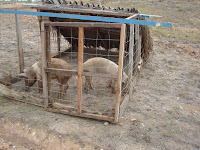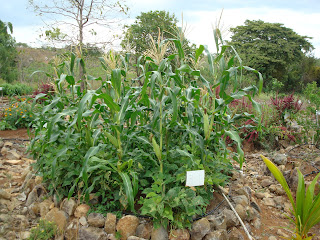As if organic farming isn't difficult enough, it seems like as in all natural endeavours that don't envolve succumbing to consumerism, major challenges and conspiracies await.
I am not sure that many people are aware but we live in a time where seeds of fruits and vegetables are in danger of extinction. In the race towards making the bigger buck, companies have invented the hybrid seed. I'm not even talking about geneticaly modified seeds.
Hybrid seeds are engineered, albeit not geneticaly, in such a way that the seeds cannot be harvested for the next crop. This means that if you buy corn, as an example, once your corn cobs are ripe and mature to be harvested, you can use the corn for food but cannot save a small amount to re-seed the next growing season. Instead, you need to contact the seed company again and buy a new batch of seeds each year.
Why is this a crime?? For one, it is completely unatural! All plants have always had seeds that could be re-used subsequently (open-pollinated seeds), it is a part of nature and allows the plant to adapt to its environment with every subsequent generation. Only the seeds from the best plants with the desired characteristics are kept in every generation, thus allowing for gradual improvement of varieties, as well as development of new varieties, which are termed as heirloom seeds.
Hybrid seeds on the other hand always remain the same. They are only improved, if so, by the manufacturer, and never adapt to the environment of the farmer. Thus, if new pests emerge, the farmer also becomes dependent on new emerging chemicals that must be used in order for the crop to survive.
Another reason why hybrid seeds are a crime, is because it creates dependency! Farmers need to spend money to get their seeds, which they never had to before. Farmers rely on more chemicals. And in the end the diversity of seeds is lost. While in the past every farmer potentialy had a different type of tomato variety. Now there is only a handful of Comercial varieties.
Lack of diversity is a huge problem in the event of natural disasters or environmental change, like climate change. The more diversity in our food supply the more chance we have of one or more of those varieties to survive or adapt to a natural disaster or environmental change.
I have discoverd this Hybrid conspiracy problem first-hand when looking to find open pollinated seeds for my farm and the farmers I work with. The main agricultural stores sell huge beautiful cans of all sorts of seeds in their fridges. When I asked the guy in charge which ones where non-hybrid, he told me that none of them!
I looked at him in surprise: "none of these are open-pollinated seeds??" He said; " nope". I said do you sell any open pollinated seeds? Then he pointed to a wooden stand mostly empty, with small paper seed packets standing in the aisle, with perhaps two different varieties, and not even in the fridge. Those were the non-hybrid seeds!
I was standing there stunned not knowing what to say or think, say or do. I though about the implications of this. I work with poor organic farmers in the cordilleras of Panama. The only thing keeping them from producing expensive crops like tomatoes and peppers is lack of seeds. And if they do find their way down to town to Melo, the most comon seed provider in the country all they come across is hybrid seeds.
I take a can of seeds out of the fridge and carefully inspect it. One whole side is covered in fine print, giving all sorts of restrictions of how these seeds may or may not be used, since they are proprietary. I gasp at the horror. I no longer see beautiful cans full of seeds, I now see something as gruesome as mutilated animal heads all lined up neatly in that fridge. That is what it has come to ladies and gentlemen! Freedom is being striped away from us from all sides. Even with something as important as our right to grow our own food.




















